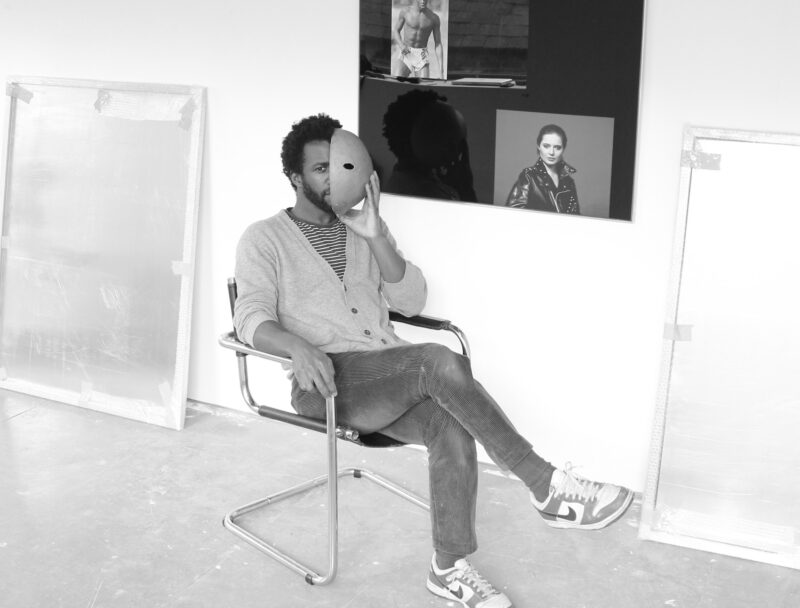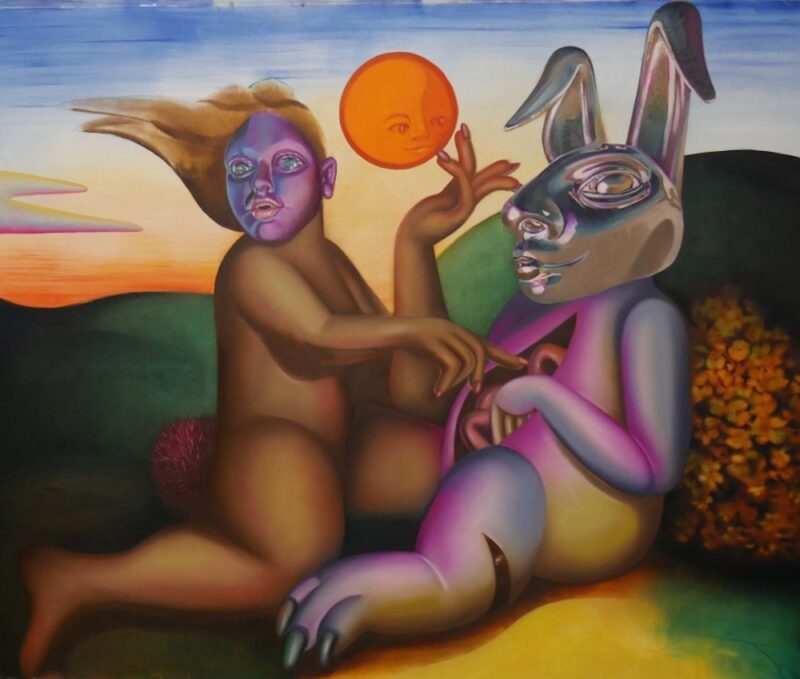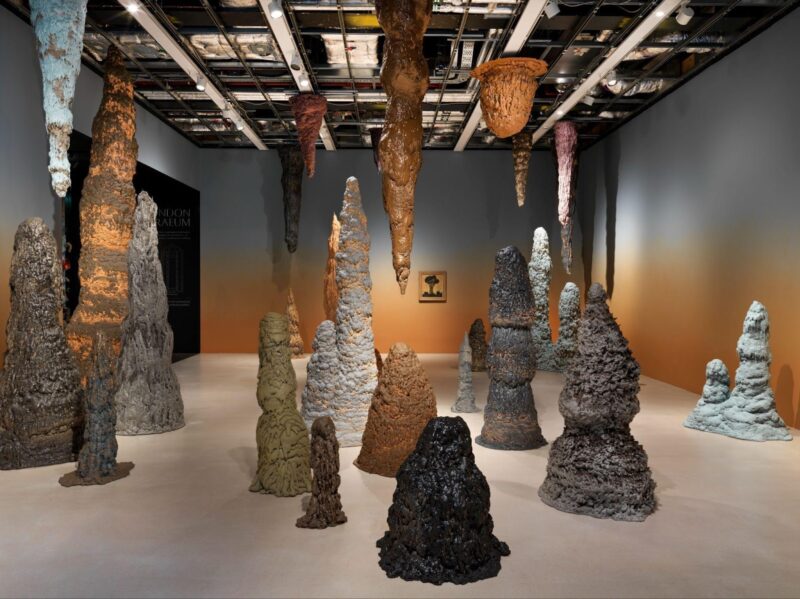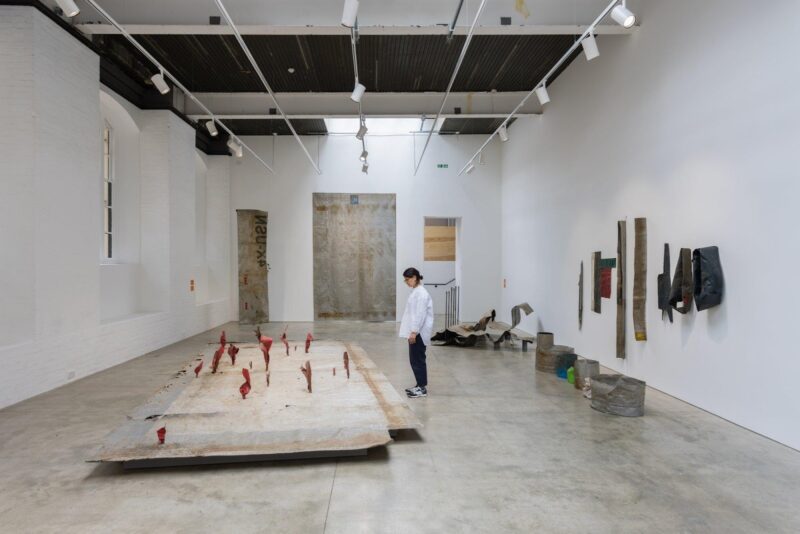Omnibus is the first-ever survey of the work of the Berlin collective Honey-Suckle Company, which brings together key moments of the group’s twenty-five-year history.
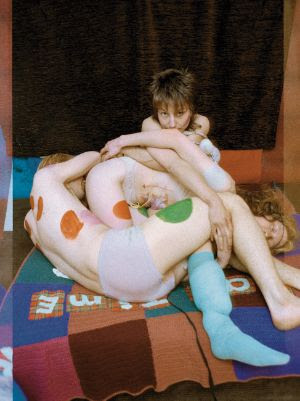
Honey-Suckle Company, Real Time Spasm – Fuck the Sugar System (It’s Easier to Make a Hole Than to Build a Pole), 1998. Performance view on the occasion of HSC3D at the 1st Berlin Biennale for Contemporary Art, 1998. Courtesy Honey-Suckle Company
Founded in 1994, Honey-Suckle Company identify themselves as a movement, built around an ongoing series of fluctuating and ephemeral interventions in fashion, music and art. The collective emerged from the post-reunification and pre-Internet cultural and social contexts of Berlin, defined by epochal underground techno and squatting scenes. The group’s name is derived from homoeopath Dr Edward Bach’s honeysuckle Flower Remedy. According to Bach, the honeysuckle plant’s homoeopathic properties helps one to learn from past experiences and re-establish a sense of trust in the future in order to feel grounded in the present. Honey-Suckle Company draw their core ethos from this hypothesis, which they project onto their lived experience of a city in a state of flux between temporalities, political ideologies and cultural movements.
Honey-Suckle Company’s work often originates out of shared living and working spaces, existing as an ongoing aspect of the group’s lives and experiences, while also appearing within more formal institutional settings. Sustained by communal methods of production, their work encompasses clothing, performances, happenings, installations, photographs, music, films and publications.
Omnibus presents key aspects of Honey-Suckle Company’s work, revealing the group’s past, present and future through an amalgamation of existing works within new installations. The exhibition begins in the ICA’s Lower Gallery, with a new multi-sensory installation that exists between a theatrical set and a post-apocalyptic archaeological dig. The exhibition concludes in the Upper Gallery with the work Materia Prima (2007) – an edgeless white room inset into the ICA’s existing architecture, which presents a complete void of visual information.
Alongside the new installation in the Lower Gallery is NEUBAND 2000 (2000/2008), which comprises mannequins adorned with sculptural, geometric outfits inspired by Kazimir Malevich’s silhouettes, mixed with prosthetic bumps and ill-fitting appendages. Utilised in recent improvised compositions and performances, the figures also function as automaton musicians, with self-playing instruments generating rhythmic pulses of sound. NEUBAND 2000 is one example of how HSC create substitutes for themselves through surrogates, which also includes the adoption of pseudonyms (such as Sim Gil, Ninja Pleasure, and PC Kišur). NEUBAND 2000 indicates HSC’s aesthetic turn towards Russian Productivism and the Bauhaus as a set of stylistic and collectivist codes.
The annex room of the Lower Gallery presents a time capsule of Honey-Suckle Company’s activities in the mid-1990s, encompassing photographic and video documentation of their work from this period. Between 1994–95, the group produced several collections of clothing, which they presented through performances, installations and films in self-run spaces such as galerie berlintokyo. Worn by highly styled members and collaborators of the group, HSC’s wearable assemblages were made using cling film, duct tape, photocopied pages from books, plastic toys, deconstructed stuffed animals and computer parts. In the group’s second clothing collection, Tape Your Own Identity, worn assemblages can be seen as ‘rotating galleries’ of favourite images and clippings from newspapers and magazines. Although created during a pre-digital period, HSC’s clothing collections reveal how the collective’s work foreshadowed many prominent aspects of social media, including projected identities and desires. Alongside the clothing collections, members of HSC produced music and performed in bands such as Synthetic (with Captain Space Sex) and Batterie ON/OFF, as recorded in the photography on display. Also exhibited are videos and animations made during the same period using Super 8mm film, Hi-8 video formats, and Nintendo Game Boy graphic programmes, suggesting various influences including Japanese noise music, punk, new wave, glam rock and techno.
In addition to Materia Prima, the Upper Gallery contains a reformulation of Ohn End (2005) and Non Est Hic (2006). These works exist within HSC’s wider engagement with Lebensreform (‘life-reform’), a late-19th and early 20th-century German and Swiss social movement which promoted a back-to-nature lifestyle and disrupted conventional social boundaries. Alongside Ohn End/Non Est Hic, the projects Eswerde (2003) and Eaude (2005) make prominent use of flowing textiles as both clothing and architecture, and integrate folk-instrumentation such as the hurdy-gurdy, drawing on a ritualistic engagement with nature. Through these navigable spatial installations, HSC create the sense of an unbounded and undefinable reality, which references the group’s interest in spirituality. In recent years, the group have extended this interest to incorporate the practice of shamanic space cleansing into their work.
While the group has sustained core friendships and creative exchanges over its twenty-five-year existence, the make-up of Honey-Suckle Company has always been in flux. Current members and collaborators include Peter Kišur, Nina Rhode, Simone Gilges, Nico Ihlein, Lina Launhardt and the musicians Konrad Sprenger and Eleni Poulou.
Stefan Kalmár says:
‘Coinciding with one hundred years of Bauhaus and thirty years since the fall of the Berlin Wall, Honey Suckle Company’s first survey at the ICA is as timely as it is long overdue. The exhibition offers a chance to reflect through Honey-Suckle Company’s work the changes that Berlin has seen over the past twenty-five years. HSC’s work echoes a contemporary moment where a younger generation is turning to values of collective care and healing through communal living and working together. Rather than focusing on corporate and commodifiable aesthetics, the group approaches collectivity as a holistic method. Honey Suckle Company’s twenty-five years of collective work attest to the powerful ideal of a liminal, collective consciousness.’
Honey-Suckle Company: Omnibus 2 October 2019 – 12 January 2020 ICA London
